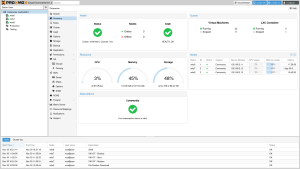Main Page: Difference between revisions
m (few grammar fixes, re-order storages so gluster doesn't comes first but ceph/zfs do and some other tiny nits) |
(add upgrade section) |
||
| Line 16: | Line 16: | ||
[https://pve.proxmox.com/wiki/Installation Read more >] | [https://pve.proxmox.com/wiki/Installation Read more >] | ||
= Upgrading Proxmox VE = | |||
[[System Software Updates]] are downloaded from the [[Package Repositories]] and should be applied frequently to receive the most recent bug/security fixes and to obtain the newest features. | |||
You can also upgrade existing Proxmox VE installations to the next major release: | |||
* [[Upgrade from 6.x to 7.0|Upgrade from Proxmox VE 6.x to 7.x]] | |||
* [[:Category:Upgrade|Upgrade Guides for older Releases]] | |||
See the [[FAQ#faq-support-table|supported release table]] for the current release and the end of life date of older releases. | |||
= Using Proxmox VE = | = Using Proxmox VE = | ||
| Line 30: | Line 40: | ||
* [[Firewall]] details how the built-in Proxmox VE Firewall works | * [[Firewall]] details how the built-in Proxmox VE Firewall works | ||
* [[User Management]] explains how the authentication and permissions work in Proxmox VE | * [[User Management]] explains how the authentication and permissions work in Proxmox VE | ||
* finally, the [[Developer Documentation]] will show you how to get access to the source code, and how to send patches so your work will be included in the next Proxmox VE release | * finally, the [[Developer Documentation]] will show you how to get access to the source code, and how to send patches, so your work will be included in the next Proxmox VE release | ||
=Offline Documentation= | =Offline Documentation= | ||
Revision as of 08:29, 24 January 2022
|
Today, 13 August 2025, there are 251 articles available. Proxmox Virtual Environment is an open source server virtualization management solution based on QEMU/KVM and LXC. You can manage virtual machines, containers, highly available clusters, storage and networks with an integrated, easy-to-use web interface or via CLI. Proxmox VE code is licensed under the GNU Affero General Public License, version 3. The project is developed and maintained by Proxmox Server Solutions GmbH. For an overview of the Proxmox VE key features see the Proxmox website. DownloadsDownload our latest ISO image. InstallationYou can install Proxmox VE either on your hardware from USB or CD-ROM using our ISO image, or alternatively on top of an existing Debian installation. Upgrading Proxmox VESystem Software Updates are downloaded from the Package Repositories and should be applied frequently to receive the most recent bug/security fixes and to obtain the newest features. You can also upgrade existing Proxmox VE installations to the next major release: See the supported release table for the current release and the end of life date of older releases. Using Proxmox VEThis wiki includes the complete Proxmox VE Reference Documentation If you are new to Proxmox VE the following chapters will help you to start:
Offline DocumentationThe complete Proxmox VE Reference Documentation is also available offline in different formats such as html, pdf or epub. This documentation is also included in each PVE installation, and is accessible via contextual help buttons. HOWTOs & Troubleshooting
Release History and RoadmapTake a look on the Roadmap for existing and upcoming features. Video TutorialsFor new Proxmox VE users, we regularly publish video tutorials on our website, see https://www.proxmox.com/training/video-tutorials. TestimonialsCompanies regardless their size, sector, or industry, as well as universities, public institutions and non-profits use Proxmox VE in their production environment. Take a look on our testimonials page. |
